11 Thoughts About The Detroit Red Wings, Summer 2024
Takes on the 2023-24 season, the offseason, and the franchise roadmap
I’ve thought about writing something on the Red Wings for a while. I didn’t do it during the season, and planned to do something right after the year, but I couldn’t get my thoughts together. Now that the bulk of the offseason has concluded, I figured now was the right time to get down to it. I don’t have anything that flows together in really coherent fashion, so I decided to go bulletpoint fashion, of somewhat interconnected thoughts on the state of the team, the season that ended in April, the offseason that just happened, and the season ahead. Hopefully it’s thought provoking, and at least somewhat enjoyable:
1. The biggest development of 2023-24 was Lucas Raymond’s emergence. I don’t think this is too shocking to say, because Raymond holds so much sway over the ability of the franchise to become a highly competitive team again. The Wings have built an ostensibly strong farm system around two-way forwards, defensemen, and goaltenders, but are lacking prospects with elite high-end offensive upside… except for Raymond. The Swede’s second half of the season was dynamite stuff, even if he was benefitting from a bit of shooting percentage luck. He scored 19 goals and 38 points over the final 37 games of the season and when the team slumped dramatically during the injury to Dylan Larkin, only Raymond continued to play at his usual level. He put the team on his back in the biggest moments of the season and looked like a future difference maker.
Again, he shot 23.5% over that span, which is something you’d expect to regress, but the underlyings looked good too. Over that same period of the time, the team outshot the opposition at 5v5 with Raymond on the ice, which wasn’t happening for many other players on the team. Raymond looked like a star in the making for Detroit, beginning to mature into a possible top line winger who can drive play and score at All-Star levels, which is so critical for the Red Wings’ future. He just turned 22 in late March and if you look at an NHL aging curve, this is around when liftoff towards a forward’s peak begins to happen. I will be watching it intently next season but for now, the Wings ought to bet on Raymond’s development and sign him long-term this summer. I don’t know if he can reach Artemi Panarin levels of stardom from the wing, but the glimpses are tantalizing with the puck on his stick. For the team’s sake, let’s hope so.
[Rick Osentoski-USA TODAY Sports]
2. Likewise, I don’t quite know what to make of Moritz Seider. Seider and his (now-departed) partner, Jake Walman, were stapled to the defensive zone and matched up against top players at a rate that was unprecedented in the analytics era and threatened to break models designed to assess quality of competition. Their results were generally terrible in terms of the territorial battle. When Seider/Walman were on the ice, the Red Wings were hemmed in their own end, ceding chances and shots. However, they also weren’t allowing goals at a terribly high rate, something that the coaching staff likely used to rationalize Seider’s usage. It helped the Red Wings win games but as a general rule, it is not a good thing if your young, supposedly star level defenseman is in his own end getting caved in shift after shift.
So what gives? Corey Sznadjer of All 3 Zones broke down the Seider predicament during the peak of the discourse and more or less came to the conclusion that fit somewhere between the analytics and the eye test, that Seider individually was doing well but subpar play of his teammates kept him hemmed in. Through three seasons it seems clear that the talent is there, a player who certainly meets the eye test. But the results have been pretty hit or miss, a great rookie year, an up-and-down second year that swung wildly based on partner, and this bizarre third season. I think it’s worth strongly considering whether burying Seider in the DZ against all of the best players in the NHL, with subpar teammates, is the best use of his talents and the best way to maximize his development. No other team uses their “#1 defenseman” this way.
As we look towards 2024-25, I feel somewhat confident that Seider can play successfully in an NHL team’s top four and will probably end up being a true top pairing defenseman when it’s all said and done. But I’m not completely sure of that and I don’t know what the ceiling is. Year #4 figures to be a big one, as he will cross the 300 games threshold I like to use to evaluate D this year. With Simon Edvinsson on the roster, I think it is in the best interest of the team and Seider to have the two more evenly split the workload this season between the two pairs, rather than putting it all on Seider’s plate. I’d also like to see him get more PP1 time to further develop his offense.
3. Simon Edvinsson is the X-Factor for 2024-25, because the rest of the D ain’t good enough. Among the reasons that the Red Wings fell just short of the playoffs this past season is their defensive depth chart is severely lacking. They didn’t do much to change it in the offseason, cap-dumping Jake Walman in an odd trade, a role Simon Edvinsson will likely fill, and then swapping PP Specialist for PP Specialist in letting Shayne Gostisbehere walk and signing Erik Gustafsson. As I look at this depth chart now, it is plainly not good enough to be a playoff team unless both Seider takes a step forward and Simon Edvinsson has an excellent rookie year. I like Edvinsson a lot, and he’s a highly regarded prospect. A former top 10 pick, he’s spent two years sharpening up in Grand Rapids and looked ready when he was called up at the end of the season.
I’m not a big fan of Jeff Petry at this point in his career and I have never liked Ben Chiarot. If the Wings are going to be more successful in 2024-25, they’re going to need Seider and Edvinsson to step up and carry the weight. Possible? I think so. Likely? Probably not. Edvinsson is going to be a rookie defenseman, we should expect there to be lumps. In a perfect world, I’d have signed UFA D Matt Roy to play with Edvinsson, a legitimately good top four defender who could help shoulder the load and bring a young left-shot guy into the league. But I understand why Yzerman was hesitant to give out six years to a 29-year-old defenseman.
Elsewhere on defense they still have a pile up of players between Gustafsson, Olli Määttä, Justin Holl, and prospect Albert Johansson, who has to be on the team due to waiver exemption status expiring. Between those four I think the Wings should be able to carve out an effective third-pair in sheltered duty, as they did last year. The bigger question in the near term is can their top two pairs not get slaughtered again? If Edvinsson is a Rookie of the Year candidate, sharing some of that load with Seider and regularly providing strong play, then yes. If he’s not quite ready for primetime, then I don’t see this team in the playoffs.
[Andreea Cardani/NHLI via Getty Images]
4. Goaltending: lots of bodies, not a lot of answers. The Red Wings ended last season with three NHL goalies on the roster and now that number has grown to four. They are running back Alex Lyon and Ville Husso and have since signed Cam Talbot and Jack Campbell. My guess is that Campbell will play primarily in the minors, as he attempts to rebuild his career after a disastrous Edmonton tenure. He played well in Bakersfield last season so he should be a steady goalie for Grand Rapids. But that still leaves three goalies, which the Wings carried last season but is always awkward. It’s nice to have three options but practically speaking it’s inconvenient. It makes practices harder, the goalies don’t like it, the coaches don’t like it, and functionally it means one guy just doesn’t play. Last year that was Alex Lyon for the first few months before Husso’s injuries. This year I’d expect it to be Husso.
Cam Talbot is a decent, veteran goalie but I’m unsure about how he’ll hold up in Detroit. He played well for the Kings last season, but LA had an excellent defensive structure and was a playoff team due to their goal prevention. The Red Wings are… not that. I am a bit worried on how the 37-year-old will hold up if the Wings make him face a lot of shots and a lot more quality than he saw in Los Angeles. But is he better than the corpse of James Reimer? Yes, and should be able to play a lot more games than Reimer if needed.
As for the others, I like Lyon but am not sure he’s a real starter sort of guy in the NHL, while Husso may not be much of anything. At this point, Husso’s resume is one-half of one good year in St. Louis and two subpar, injury-riddled years in Detroit. I’d roll with a 1A/1B tandem of Talbot/Lyon and then mix in Husso every so often until he inevitably gets injured. Is that good enough for the playoffs? Ehhhhhhh. You need Talbot to prove he’s still got it and the defense to give the goaltenders more support than they did last year. I’m not counting on it.
5. I love the franchise’s goalie pipeline, though. As lukewarm as I am on the goalie depth chart for 2024-25, I am cognizant of the reality that these are placeholders until the young guns arrive. Sebastian Cossa, former first round pick back in 2021, is a fine goalie prospect with tons of potential at 6’6”. He posted a .913 SV% on Grand Rapids last season and will likely spend another year sharpening up there. If he can take his game to another level next season, perhaps a full-time debut in 2025-26 at age 22 makes sense.
Cossa is one of the better goalie prospects in the NHL but what I really like is the existence of Trey Augustine, last year’s 2nd round pick. I got to watch a lot of Augustine in the NCAA last season with Michigan State and he really impressed me. Augustine’s numbers weren’t dominant, but MSU was a high powered offensive team with an often subpar defense. Augustine, especially against high end teams like BC or Michigan, faced a lot of high-danger chances and gave his team chances to win. He showed a lot of dawg in him, rising to the occasion in big moments, which included a sterling performance at the World Juniors for Team USA. Augustine is only 19 with one year of college hockey under his belt, but he’s also one of the better goalie prospects in the league in my view.
The combination of Augustine/Cossa is a nice luxury. Goalies are so unpredictable, especially as prospects, so I’m a quantity over quality sort of guy. I don’t know whether Cossa becomes a starting caliber NHL goalie and the same for Augustine, but I view them both as lottery tickets, with decent odds that at least one becomes a future starter. Let them both develop, with Cossa ahead of Augustine in terms of age and development, and hopefully in a couple years you have something. If one of the two ends up hitting, they could be a crucial piece in a playoff contending team.
[Detroit Free Press]
6. Forward talent: status quo after the offseason. The Red Wings said goodbye to David Perron, but signed Vlad Tarasenko. They said goodbye to Daniel Sprong, but signed Tyler Motte. They re-signed Patrick Kane and Christian Fischer, and then cap-dumped Robby Fabbri, presumably to replace him with a prospect, be it Jonatan Berggren or someone like Carter Mazur. As a whole, I view that as pretty neutral. Losing Sprong is a major subtraction in goalscoring, but Motte is obviously a huge upgrade on Sprong defensively. Swapping Perron for Tarasenko probably isn’t much difference other than a bit of a different type of player. From a talent standpoint, not much change.
Which I think is probably okay. The Red Wings have a lot of the pieces of what a good team would be expected to have, but without the top end talent (or the stability on D/G) to get it there. They could have a possibly very good top line with Raymond, Dylan Larkin, and Alex DeBrincat. They have some support scorers in Patrick Kane and Vlad Tarasenko. They have centers who can play a two-way game in Andrew Copp and JT Compher. They have guys who can kill penalties in those two + Fischer and Motte. It’s an “okay” forward depth chart, one that makes sense and should be able to be the meat of a mediocre team but needs Lucas Raymond to make that leap to become legitimately dangerous.
7. Detroit is probably on the outside looking in for the playoffs. After the stinging defeat of last season, with an engaging playoff chase that literally came down to the final seconds, so much focus in Hockeytown is on making the playoffs. From the 25 year playoff streak to a nearly decade-long drought, I get the desire to see the team jump back in. But right now, I would not project that to happen based on this roster and a very deep Eastern Conference. I certainly am not ruling out the possibility, but there are only so many spots up for grabs and a lot of teams vying for those.
You figure that the big dogs in the East all still have their spots. I struggle to see the NY Rangers, Carolina, or Florida dropping out. I also think it’s pretty likely Toronto, Boston, and Tampa Bay make the postseason, though I could see perhaps 1 of those 3 falling out. I also think New Jersey likely makes a jump back in based on how much they upgraded their goaltending in the offseason and how talented the roster is. That leaves 1 or maybe 2 spots for the following teams: Detroit, Buffalo, Ottawa, Washington, Pittsburgh, NY Islanders, and Philadelphia. Last season was a pile up, with all of those teams between 94 and 84 points save for Ottawa, who flopped due to terrible goaltending that they improved significantly in the offseason. I expect it to be pretty tight again.
By virtue of so many teams fighting for so few spots, I don’t think the individual odds of any of those teams making it in can be more than ~1/3, including the Red Wings. I expect them to be in the hunt. I don’t expect them to make it in, with a roster that didn’t change much from a team that missed the postseason last year and had pretty woeful underlying metrics despite the reasonable on-ice results. Young players maturing and improving could well make the team better… but it also could not be enough, even with the competition being so fierce.
[Richard T Gagnon/Getty Images]
8. Not pushing hard for the playoffs immediately is okay with me. I am fine with the previous bullet point about the team not being ready for the postseason in 2024-25, which I suppose differentiates me from a lot of the playoff starved fanbase. Outside the idea of getting someone like the aforementioned Matt Roy, I was fine with Yzerman holding off from spending aggressively in free agency. A lot of those deals will probably age poorly and the timelines to extract maximum value don’t really lineup with where the Red Wings are in their franchise life cycle.
That being said, the life cycle is a bit difficult to ascertain right now, as the Red Wings have gone about building their team in an unusual way. Unlike fellow Atlantic rebuilding squads Buffalo and Ottawa, the riches of the rebuild are not on the roster. Rather, this is still a mostly veteran team with a lot of the draft still in the minors, outside of a couple names mentioned in this piece. It’s made it difficult to judge what the team’s plan is year-to-year, as they’ve alternated between cautious offseasons like this one and spending more heavily on players like Andrew Copp, JT Compher, and Ben Chiarot in summers past.
But right now this is still not a win now team. They need to upgrade the defense and add more impact forwards, as well as straighten out the goalie position, to be the sort of team that is a big spender on July 1st. Yzerman was right abut that, but he no doubt will feel somewhat unnecessary heat from less-informed fans who simply want to see the playoffs and were coaxed into thinking that was the only goal based on last season, and previous offseasons. Most teams rebuild by being objectively terrible until it’s time to start getting better and then rapidly spend alongside promoting young prospects in waves. The Red Wings have instead gone for a bit of a hybrid, integrated model that leans more heavily on veterans and which looks more like a two steps forward, one step back sort of thing, rather than a linear progression. Only time will tell if they pull it off.
9. I don’t feel much different about the “Yzerplan” than I did last summer. This time last year, I penned a big “defense” of Yzerman on this site, basically arguing that analyst grumbling about signing JT Compher was misplaced because ultimately all that matters for the “Yzerplan’s” success is whether his prospects hit. That’s still the case now. I laid out the case last summer, arguing that while I do think the Red Wings need to focus on raising their ceiling by drafting/acquiring forwards more for high-end offensive talent, the blueprint of becoming a contender based more around defense is entirely believable.
Building around a bunch of top four/star caliber defensemen, savvy two-way centers, strong goaltending, and scoring but not superstar wingers is basically the blueprint used by St. Louis, Los Angeles, and Nashville of the 2010s, all of whom were very good teams. It’s also not that far from the blueprint used by the 2023 Vegas Golden Knights, who built around having a bunch of players ranked between 25th and 100th best in the league, rather than a superstar-based, Edmonton model. The Red Wings not drafting Connor Bedard or Macklin Celebrini is not the end of the world for their ability to become a contending squad. Defense very much wins championships in hockey and they do have a very promising defensive pipeline.
Of course, we’ve been saying that for years. But it’s still true! I think that Moritz Seider, Simon Edvinsson, Axel Sandin-Pelikka, and William Wallinder is a very interesting quartet of prospects. If you hit on those guys and get an awesome top four on your blue line, that’s absolutely something that could be the backbone of a contender. The same for if one of Cossa/Augustine hits and you get a very good starting goalie. Drafting around high work ethic, competitive two-way centers (or wingers, in the case of Michael Brandsegg-Nygård) like Nate Danielson and Marco Kasper isn’t insane either, since it’s a premium position. You still have Dylan Larkin and obviously Lucas Raymond holds the keys, as I’ve mentioned.
There are enough pieces in this farm system to build a good team. I don’t know if it will be a best-of-the-best contender, but as I’ve also argued, the building doesn’t stop at drafting. Adding talent through trades and free agency is a very crucial route to team-building, as Vegas (among others) showed. So ultimately, my take on the “Yzerplan” is the same as it was. If most of the first round picks he’s taken over the last five years become impactful NHLers, the team will probably be good. If those picks don’t pan out, the plan will have failed. #Analysis. People are impatient and want to find shreds of evidence either way as soon as possible, but until the verdict is in on those players, the verdict won’t be in on the Yzerplan either.
[USA Today]
10. I do have some concerns about the displayed ability of management to make the right pro scouting decisions when it comes to free agency/trades to help build this team. I don’t think that Yzerman has been terrible in his moves made at the NHL level with the Red Wings. I also don’t know that he’s been particularly great. I still like doing the DeBrincat deal, even if he had an up-and-down first year. I think he’s generally had a good feel for where the team is in their decisions to sell off pieces at past deadlines (2023 in particular) and I thought he was smart to hold off buying at the most recent deadline. I think he’s also made some solid signings to help get this team on the verge of the playoffs in the spring.
At the same time there have been some concerning errors. Every GM is going to have mistakes but some of the pitfalls felt preventable. I hated the Ben Chiarot signing at the time and still dislike it. It never felt like the team was well situated to use Justin Holl to maximum effectiveness and he was a nearly automatic healthy scratch in the first year of a three year contract. The Ville Husso contract has also been a total whiff (though low stakes) and I thought the Jake Walman trade a few weeks back was bizarre, a shockingly high price to pay given the price to move money displayed by other teams.1 I also am unsure of whether Derek Lalonde is the right guy behind the bench.
In other words, I don’t know that Yzerman isn’t the GM to build this team up, but I also haven’t seen enough in Detroit to know that he is. He’s mostly signed mediocre players (some good, some bad) and drafted prospects we mostly haven’t seen yet. It’s why following the Red Wings has felt a bit like following a team in a holding pattern, waiting for the young players to arrive to either take this team to the next level or flop entirely, since Yzerman’s signings haven’t been big enough swings or impactful enough to do it on their own. The pro scouting has been a bit of a mixed bag and I need to see more to fully believe.
I also have some concerns about the front office’s makeup, as a group increasingly dominated by former players seemingly picked on the achievements of their playing career and not the merits of their ability. Scroll the list of the Red Wings’ Hockey Ops department and it’s a who’s who of mid-2000s former Red Wings players. That sort of thinking, where past playing glories obviously predispose you to management success, is the very thing that led other post-dynasty teams off a cliff (see: Edmonton and Montreal). Yzerman didn’t end up bringing too many people from Tampa with him and I worry that the front office he’s built in Detroit is too much of an Old Boys Club and they’re ignoring the best/brightest and most qualified. I have no proof that that’s the case, but it’s a thought I’ve had recently and wanted to include it.
11. This upcoming season feels like a big one. I will conclude with this thought. The unusual building blueprint I’ve discussed eventually has to yield some results and even if that may not be the playoffs, we’re getting to the point where we’re going to start learning crucial information on key players. Those prospects that have led evaluations of the Yzerplan to be “TBD” are going to be closer to– or in– the NHL. The continued development of Raymond and how Seider fares in year #4 are huge questions, as I mentioned. Edvinsson will be in the NHL full-time and we could see more prospects like Johansson, Berggren, and maybe some of the other forwards. It’s theoretically possible that Sebastian Cossa could play NHL games too.
Over the next few seasons, beginning with this coming year, we will learn a lot of information about whether the supposedly vaunted farm system that Yzerman built is good enough to build the core of a playoff team. They very carefully laid the bricks, now it’s starting to round towards time to step back and see if a house is standing. I don’t think they have to make the playoffs in 2024-25 for the season to be a success, but continued growth from those young players and promising signs need to be exhibited. At the very least, watching the real “future” take up more of the ice (as well as a living legend like Patrick Kane) should be more exciting than watching too many mediocre veterans try and grind out 85 points.
The Canucks paid essentially a third round pick (gave up a 2nd but got back a 4th) to move Ilya Mikheyev, who had a more expensive contract and also (in my view) is a worse hockey player than Walman. None of the reporting after the fact confirms Yzerman’s claims that this was the price he had to pay to move Walman, as other GMs have stated they would’ve given up assets to get him



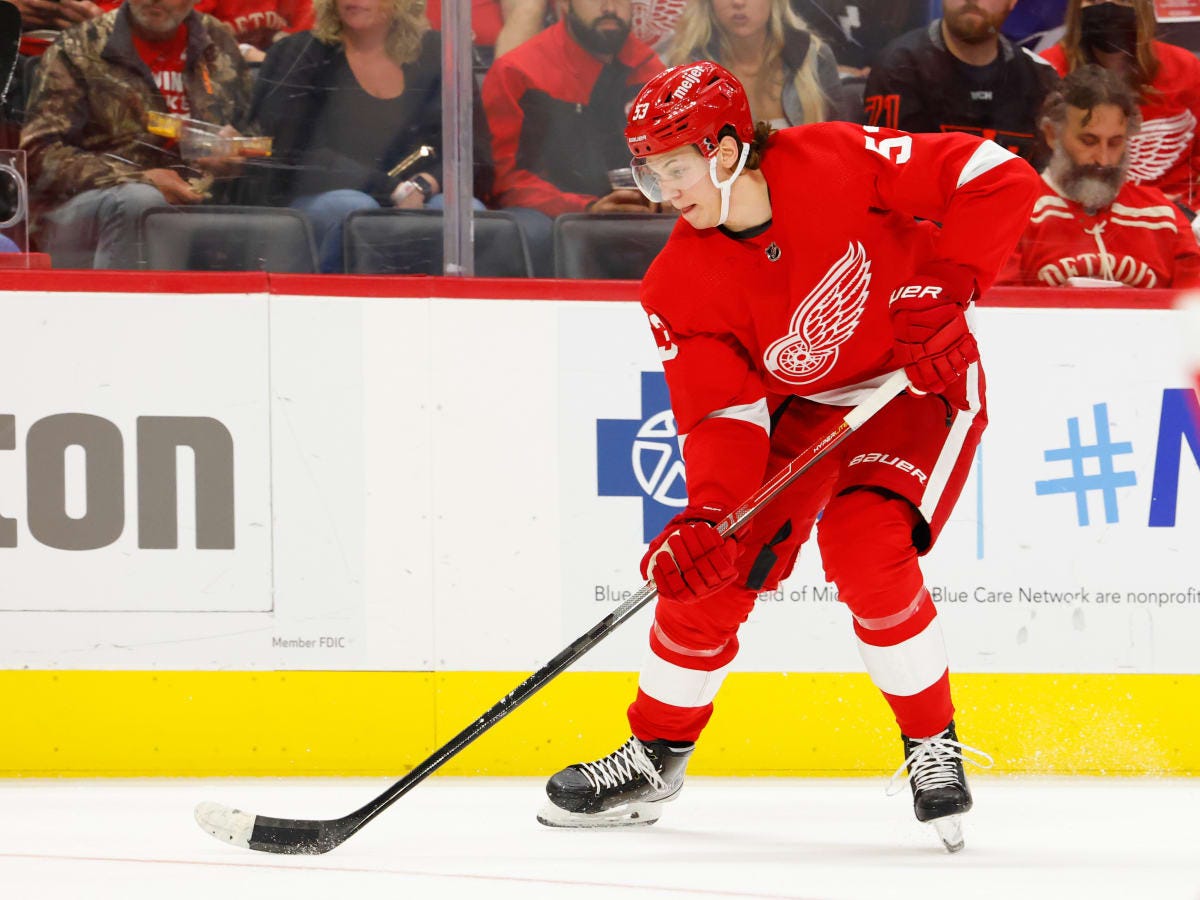
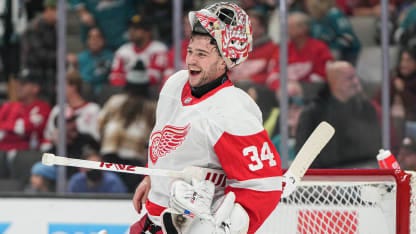
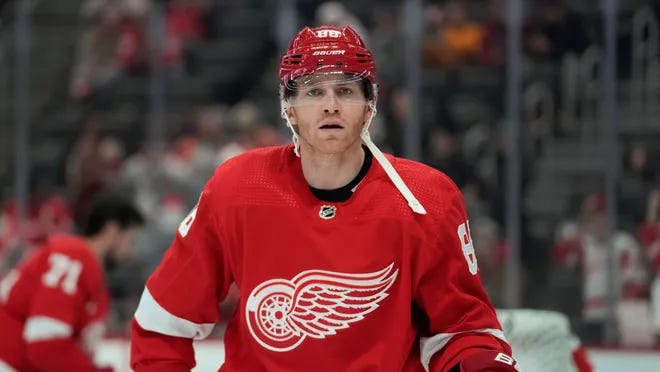
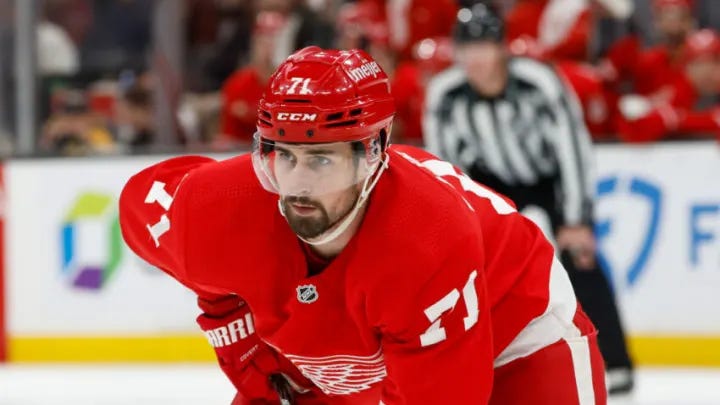
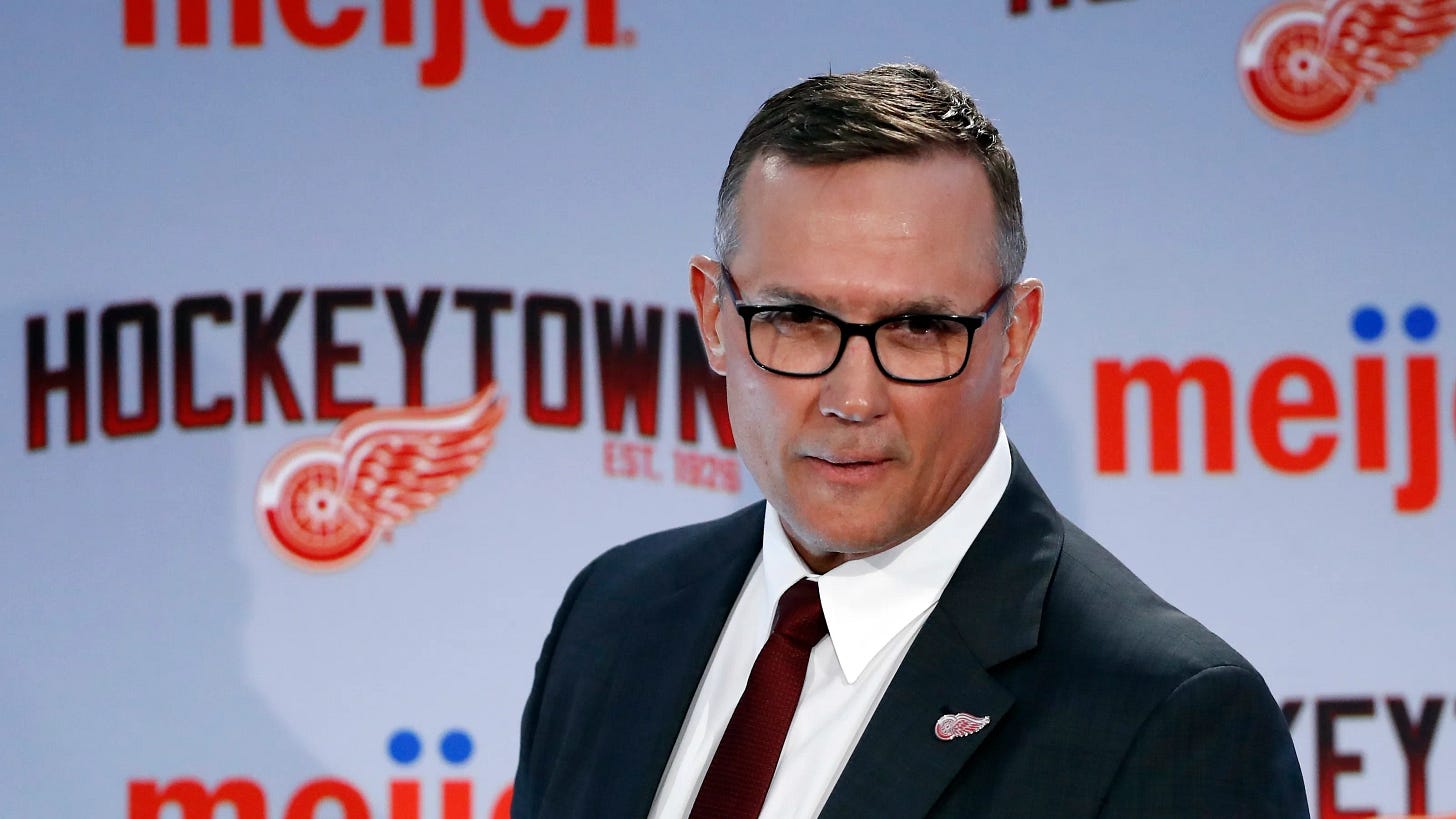
Incredibly comprehensive analysis, Thanks.